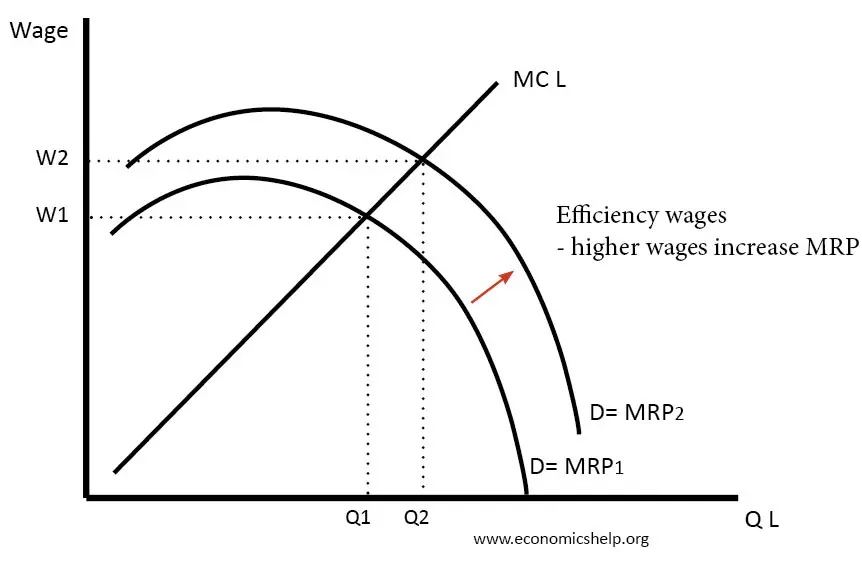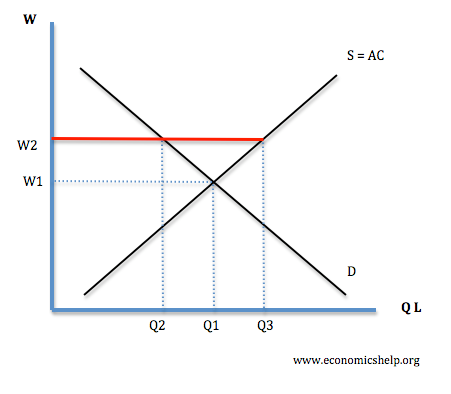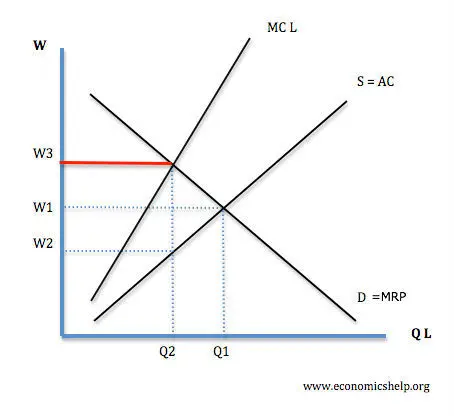Definition of Efficiency Wage Theory / Hypothesis
The idea of the efficiency wage theory is that increasing wages can lead to increased labour productivity because workers feel more motivated to work with higher pay.
Therefore if firms increase wages – some or all of the higher wage costs will be recouped through increased staff retention and higher labour productivity.

In theory, higher wages could cause increased labour productivity (MRP). In this case, the wage increases can pay for themselves.

Reasons for efficiency wage theory
Fear of losing jobs – “Shirking model”. The argument is that if workers are paid a higher wage, they have more to lose from being made redundant. Therefore, if they have a job with a wage significantly higher than benefits or alternative jobs, they will have greater motivation to impress their boss and keep it. Shapiro and Stiglitz posited that workers with a higher wage will work at an effort level which involves no shirking. This wage is above market-clearing levels.
Loyalty. Secondly, if workers receive a higher pay, they may just feel more loyalty towards the company and be willing to work harder and with more determination. By contrast, if they feel they are being exploited by a monopsonist employer, then they will do the minimum amount of work to get by, but try to take more breaks and not work as hard.
Labour market “Gift Exchange” G. Akerlof (1982) saw the labour market has a ‘gift exchange’ where good labour relations depended on goodwill. FIrms could pay wages above market-clearing levels, and in return, workers would take on more responsibility and initiative.
Lower costs of supervision. JB Rebitzer (1995). Rebitzer noted that lower wages were associated with higher levels of supervision. WOrkers receiving higher wages were more motivated and therefore needed less managerial supervision.
Attract higher quality labour. If a firm pays above the market clearing level, it will attract a better quality worker who will feel they can get a relatively better-paid job.
Nutritional theories. In developing economies at very low rates of pay, increasing wages can enable a reduction in absolute poverty – better health, and nutrition lead to better quality labour.
Efficiency wage theory and involuntary unemployment

Shirking models of efficiency wage theory, state that employers have an incentive to pay a wage above the market clearing level. If this is the case, and efficiency wage payments are widespread then it can cause involuntary unemployment with wages above the equilibrium and wages.

However, in the case of monopsony, higher wages can increases wages without any cost of unemployment.
Examples of minimum efficiency wage
A test case for the minimum efficiency wage was in 1914 when Henry Ford introduced a five dollar day. Ford paid well above the market-clearing rate. He wanted to pay higher wages in order to
- Ban unions. A condition for high pay was no trade unions
- Compensate for boring work on his efficient assembly lines. Ford increased productivity by the revolutionary use of assembly lines, but was worried a low wage, workers would get bored and stop working.
Raff and Summers (1986) concluded that Ford’s five dollar day was consistent with what was expected of efficiency wage theories.
“There is vivid evidence that the five-dollar day resulted in substantial queues for Ford jobs. Finally, significant increases in productivity and profits at Ford accompanied the introduction of the five-dollar day.”
Raff, Summers “Did Henry Ford pay efficiency wages” (1986) NBER
Limitations of efficiency wage theory
- In practice, many factors determine worker morale and productivity, wages are just one of them. Often other factors are more important such as work conditions, management, e.t.c. If non-wage factors are negative, then higher wages may be insufficient to boost productivity.
- It depends on the reaction of other firms. If other firms also start paying above market clearing levels, then the gain from attracting the best quality workers will be lost.
- Firms with monopsony power may not need to pay higher wages to create the threat of workers losing their jobs.
